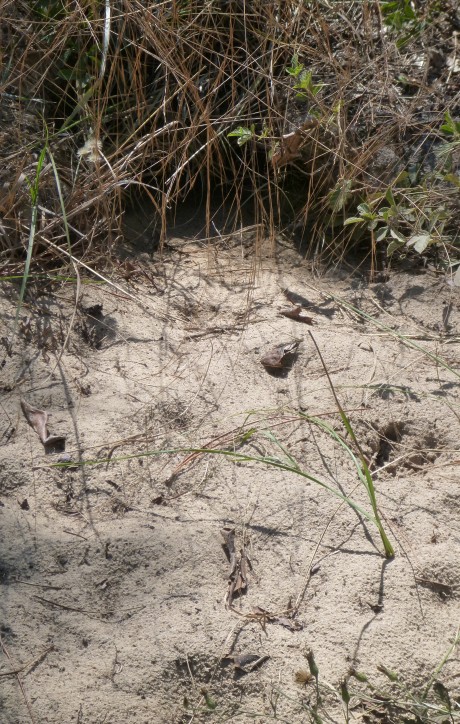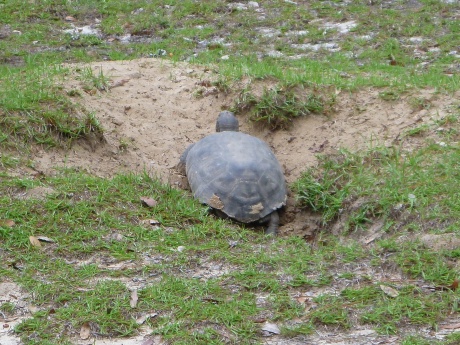Family: Testudinidae
Endangered species due to loss of habitat
Next to bathroom building in a fenced enclosure. Please respect its right to exist free from human harassment.
The word “tortoise” is applied only to exclusively terrestrial species and does not include the terrestrial box turtle. Hence, the gopher tortoise is the only native tortoise found east of the Mississippi. However, the African spurred tortoise (Geochelone sulcata), purchased from pet stores and released, have been noted in Florida. These feral tortoises grow to more than 200 pounds (males), 100 pounds (female). It is illegal to release the African spurred tortoise.
Gopher tortoise’ trace their descent from a species of land tortoise which inhabitated western North American 60 million years ago.
Averaging at maturity from 9 to 11 inches long, they can live for 60 or more years in the wild. Their burrows average 15 feet long and 6.5 feet deep and maintain a fairly consistent humidity and temperature.
They need habitats in which fire is not suppressed because their diet is mainly tender herbs which occur where is no heavy shrubbery and undergrowth. They eat wiregrass, broadleaf grassses, legumes, prickly pear cactus, blackberries, paw-paws, saw palmetto berries and other seasonal fruit. They will also feed on dead animals and excrement. They prefer sandy soils in areas with sparse tree canopy and with lots of low growing vegetation. Their deep burrows protect them from periodic forest fires, essential if they are to thrive.
Sexual maturity is from 9-21 years and they usually breed in early spring. The nest is dug close to their burrow opening and a clutch of 4-7 ping-pong sized eggs are laid, hatching from 80-110 days. The sex of the young are determined by the temperature of the sand or dirt in which they are laid, above 85 degrees, female; anything below, males. The hatchlings are from 1-2 inches long and they grow about 3/4 inches a year. The young may spend the first winter in the mother’s burrow.
An important animal in its ecosystem, its burrows are shared with over 350 other species, such as indigo snakes, burrowing owls, rabbits, gopher frogs, eastern diamondback rattlesnakes, gopher crickets, Florida mice, opposums. Gopher tortoises are a keystone specie: its existence enables other species to survive. As gopher tortoise populations shrink, so do the animals which rely upon the burrows of this reptile.
A good source of additional information for children and parents is http://www.myfwc.com/education/wildlife/gopher-tortoise/.

This is another gopher tortoise opening which may have been abandoned along road leading to Nick’s Road campsite. Discovered on November 10, 2016.

